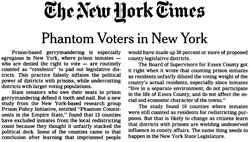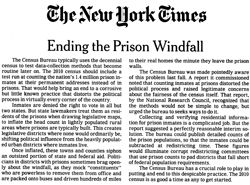Census Bureau’s counting of prisoners in their districts of incarceration rather than their home districts leads to violation of international treaty.
December 13, 2007
International Treaty Violation Also Cited
NEW YORK, Dec. 13 — The United States Census practice of counting prisoners in their districts of incarceration rather than their home districts for the purpose of establishing electoral and Congressional representation is a violation of international treaty. This month, the non-partisan public policy and advocacy centers Demos and the Prison Policy Initiative (PPI) submitted their analysis to the Committee for the Elimination of Racial Discrimination (CERD) in Geneva.
Continue reading →
by Peter Wagner,
October 30, 2007
The New York Times editorial page reported yesterday that a budget dispute between the Bush Administration and Congress is endangering the 2010 Census. In response to the budget shortfall, the Census Bureau has canceled next year’s practice count of people in prison, military barracks, college dorms, nursing homes, and shelters. Further cuts in Census preparations are expected unless the budget is restored by mid-November.
Continue reading →
Article examines how the prisoner miscount distorts democracy in Ohio cities that have large prisons and highlights one city for excluding the prison population prior to redistricting.
by John Hejduk,
October 24, 2007
With the 2010 Census approaching, a key question presents itself: Where should Ohio’s prison population be counted? There is a nationwide controversy about the Census Bureau’s practice of counting prisoners as residents of the prison location. This practice unconstitutionally inflates political clout in rural prison towns by counting nonvoting prisoners as part of the constituency. Even though the Constitution dictates that all votes be given equal weight, the Census’s method for counting prisoners has caused some areas to afford voters more than twice the power of others. Though the issue has been addressed at the state level, the prisoner miscount’s impact on local government has been much more severe and has gone largely unnoticed.
Continue reading →
Senator Schneiderman and other elected officials announce national letter-writing campaign to urge Census Bureau policy change on prison population count.
October 18, 2007
Announce National Letter-Writing Campaign to Urge Policy Change
For Immediate Release:
October 18, 2007
Contact: Michael Meade 646-522-8601
Peter Wagner (413) 527-0845
Today, State Senator Eric Schneiderman, Peter Wagner, Executive Director of the Prison Policy Initiative, State Senators Eric Adams and Liz Krueger, Assemblymembers Adriano Espaillat, Micah Kellner, Keith Wright and Adam Clayton Powell, Council Members Robert Jackson, Miguel Martinez, and Melissa Mark Viverito and criminal justice and democracy advocates called on the United States Census Bureau to begin counting prisoners in their home communities, rather than where they are incarcerated. Elected officials and advocates also announced the beginning of a national letter-writing campaign by local elected officials in New York and around the country to urge a change in this policy.
Continue reading →
by New York Times,
July 23, 2007
 Prison-based gerrymandering is especially egregious in New York, where prison inmates — who are denied the right to vote — are routinely counted as “residents” to pad out legislative districts. This practice falsely inflates the political power of districts with prisons, while undercutting districts with larger voting populations.
Prison-based gerrymandering is especially egregious in New York, where prison inmates — who are denied the right to vote — are routinely counted as “residents” to pad out legislative districts. This practice falsely inflates the political power of districts with prisons, while undercutting districts with larger voting populations.
Continue reading →
Report explains that New York counties violate state constitution by relying on Census data that counts prisoners as residents of the prison location.
July 18, 2007
Contact: Peter Wagner, 413/527-0845
July 18 – The federal Census counts state and federal prisoners as part of the local population, and that creates big problems for county government, charges a new report by the Prison Policy Initiative. The report explains that the Census Bureau wants New York county governments to use its data but counts prisoners as residents of the prison location, which violates the New York State Constitution. Counting prisoners as residents, despite the fact that they can’t vote or participate in the communities where they are incarcerated, leads to unequal distributions of political power.
Continue reading →
by Peter Wagner,
April 18, 2007
It should come as no surprise that one of the few people to publicly oppose changing the way the U.S. Census Bureau counts people in prison would be the New York State Senator with the largest imprisoned population: Senator Elizabeth Little. What is noteworthy, however, is that Little’s recent comments to the Glens Falls Post-Star rest upon some of the most common fallacies about how our criminal justice and electoral systems work.
Continue reading →
Prison Policy Initiative launches set of online tools to help rural citizens determine if prisons are diluting their right to equal representation.
by Peter Wagner,
April 10, 2007
Today the Prison Policy Initiative launched the Democracy Toolkit, a set of online tools designed to help rural citizens determine if prison populations in legislative districts are diluting their right to equal representation. Despite the fact that people in prison remain legal residents of the place they lived prior to their incarceration, the Census Bureau counts people in prison as if they were willing residents of the prison location.
Continue reading →
by New York Times,
January 17, 2007

The Census Bureau typically uses the decennial census to test data-collection methods that become routine later on. The 2010 census should include a test run at counting the nation’s 1.4 million prison inmates at their permanent addresses instead of in prisons. That would help bring an end to a corrosive but little known practice that distorts the political process in virtually every corner of the country.
Continue reading →
Census miscount of prisoners skews legislative power across nation, but states can adjust Census data to use actual resident populations in redistricting.
January 3, 2007
FOR IMMEDIATE RELEASE —
Every decade, the Census Bureau counts tens of thousands of Chicagoans incarcerated in state prisons as if they were part of downstate communities, diluting the votes of Chicagoans and distorting how Illinois draws its legislative districts. The next census is less than four years away, and the Census Bureau is resisting calls to start counting prisoners as residents of their legal home addresses.
States are not powerless victims of this misguided census enumeration policy, however, points out a new article in Northwestern University’s prestigious Journal of Criminal Law and Criminology. Instead, Illinois and other states may legally apportion citizens to reflect their true legal residence rather than the misleading usual residence employed by the Census Bureau.
Continue reading →
 Prison-based gerrymandering is especially egregious in New York, where prison inmates — who are denied the right to vote — are routinely counted as “residents” to pad out legislative districts. This practice falsely inflates the political power of districts with prisons, while undercutting districts with larger voting populations.
Prison-based gerrymandering is especially egregious in New York, where prison inmates — who are denied the right to vote — are routinely counted as “residents” to pad out legislative districts. This practice falsely inflates the political power of districts with prisons, while undercutting districts with larger voting populations.




